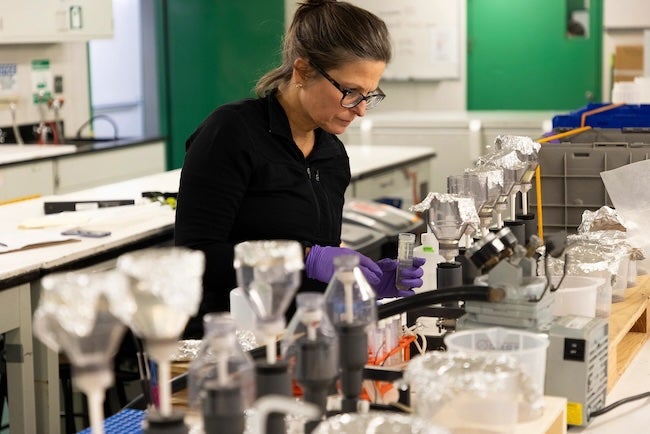Professor Rebecca Robinson to examine samples from the subsurface south of Martha’s Vineyard
May 20, 2025
Scientists were surprised when they discovered freshened (slightly saline) water beneath the ocean’s floor in the 1960’s. For the first time, a team of researchers is conducting a dedicated, hydrogeological study of an offshore freshened groundwater system to better understand the formation, evolution, and longevity of such systems globally.
Rebecca Robinson, a professor at GSO, has joined scientists from 13 countries on a three-month expedition, which departed from the port of Bridgeport in Connecticut on May 19. She is one of 41 scientists who will study water and sediment samples taken from up to three locations beneath the ocean on the New England Shelf, south of Martha’s Vineyard, Massachusetts. Robinson, who is also an associate director of URI’s Coastal Institute, will serve as an organic geochemist.

“My roles on board will be to participate in the sampling of fluids and gases within the sediment,” said Robinson. “I’m interested in the nutrient cycling that happens in the fluids in the subsurface—think of it happening in the fluid between the grains. The fluid hosts microbes and chemical reactions that we can investigate to better understand the conditions in the system.”
The Expedition 501 New England Shelf Hydrogeology is conducted by the European Consortium for Ocean Research Drilling as part of the International Ocean Drilling Programme (IODP³), co-funded by IODP³ and the National Science Foundation. The co-chief scientists are Brandon Dugan, a hydrologist from the Colorado School of Mines, and Karen Johannesson, an environmental geochemist from the University of Massachusetts Boston.
The team is using the 185-foot-long liftboat Robert. The boat is equipped with a small drilling rig, used to collect sediment cores and water samples at a maximum depth of 550 meters below the ocean floor. The locations were identified through preliminary geoscientific investigations.
The researchers hope to learn about the origins of freshened groundwater in offshore aquifers so that they can confirm or dismiss existing theories. One theory is that fresh water may be percolating all the way down through the shelf from aquifers on land. Another theory suggests the fresh water came from glaciers during ice ages, when sea level was lower, and the continental shelf was exposed dry land. According to the theory, when the glaciers melted, the fresh water was trapped beneath the seafloor when sea levels rose.
The research is also essential for a better understanding of the biogeochemical and elemental cycles in the continental shelf environment and will support a focus on the protection and sustainable management of offshore freshwater systems.
“We will look at the origin and age of the groundwater, the biological and chemical activity that occurs when freshened water infiltrates ocean sediments, and how these changes may impact the fluids that make their way into the ocean as submarine groundwater discharge,” said Robinson. “I will focus on the nitrogen cycling in the subsurface. I seek to understand how much nitrogen is there, where it came from, and who has used it. Finally, I hope we can learn how the influx of this nitrogen from the subseafloor might influence the ocean nitrogen cycle.”
The expedition is expected to conclude in early August 2025, but a second phase of the project will take place in January 2026. The full science team will convene at the University of Bremen’s core repository in Bremen, Germany, where they will split, sample, and analyze the sediment cores and interpret the data.
The cores will be archived and made accessible for further scientific research for the scientific community after a one year-moratorium period. All expedition data will be open access and resulting outcomes published.

